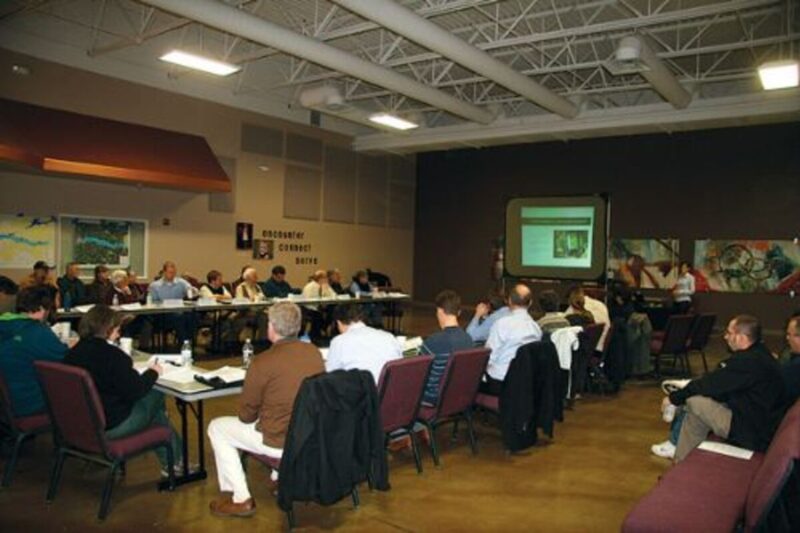Sean C. Morgan
Gathering at Lebanon’s River Center brings together some 50 interested people Monday
The Oregon Solutions Project team took its first look at a draft vision for the proposed South Santiam Community Forest Corridor Monday afternoon, Jan. 7, in its inaugural meeting in Lebanon.
The designation of the Oregon Solutions Team by Gov. John Kitzhaber has created a group of interested and affected parties representing federal, state and local interests, who will gather every few weeks over the next six to eight months to effectively cut through red tape and other hindrances to the establishment of a forest of public and private lands between Sweet Home and Cascadia – and possibly beyond.
The team that met Monday at the River Center in Lebanon included approximately 25 members appointed by the governor and his staff, and about 25 others who are interested in the project. Represented were a variety of organizations, agencies and businesses, including the city of Sweet Home, the U.S. Forest Service, The U.S. Army Corps of Engineers, the Oregon Department of Forestry, Linn County Parks and Recreation, the Linn County Board of Commissioners, Samaritan Health Services, Oregon State University, the University of Oregon, Travel Oregon, the Confederated Tribes of the Grand Ronde, the Sweet Home Active Revitalization Effort, the Sweet Home Economic Development Group, Cascade Timber Consulting and more.
The draft vision defines long-term goals and anticipated outcomes for the project, which is aimed at enhancing recreational and economic opportunities in the 12-mile stretch of forest along the South Santiam River, from Sweet Home to the Willamette National Forest.
The document provides a starting point for the Oregon Solutions Project to develop the community forest concept over the next year.
It attempts to capture the interests and ideas that have been expressed to date, said Eric White of the Oregon State University College of Forestry. It provides an opportunity for discussion and focusing goals for the process.
There’s a wide array of activities the project team could do, he said, but there is a short window to do it – a year.
The vision reflects the Sweet Home All-Lands Collaborative committee’s expectations, and it has been reviewed by the SHALC members and project team leaders before its presentation to the full team Monday.
Sweet Home-area residents recognize the historic and cultural connections to the river and natural resources, White said, explaining the purpose identified in the draft vision document. The physical connections between the residents, public resources and forests along the community forest corridor can be improved.
“The public and private forests of this landscape support the local economy, provide recreation opportunities and support important natural benefits such as clean water, habitat and cultural sites,” the draft vision document said. “Local leaders would like to see these connections established and find better ways to ensure public access, support jobs and promote forest health along the river.”
The long-term goal of the corridor is to provide a physical connection from Sweet Home to the Willamette National Forest and the Old Santiam Wagon Road, White said. It should contribute to the quality of life for residents, including health, economic development and recreation, something that can excite residents and reflects their values.
Among other long-term goals is ensuring public access to the river, which would provide economic development and natural resource benefits such as forest byproducts, and protecting important cultural resources within the corridor, such as Cascadia Cave.
The corridor would be formed from public and private lands, White said. Existing public lands and partnerships would provide the anchors.
The corridor would focus on respecting the rights and values of landowners, collaborative government and creating win-win opportunities, he said.
The corridor would need to be self-financing, with funding from various sources, such as grants or from land management inside and outside the corridor, White said.
One observer was concerned about whether the formation of the community forest corridor would cut off hunting.
That will be considered, White said.
It could become a connection to hunting, said Linn County Commissioner Will Tucker. Right now, “I can’t hunt where I used to.”
He encounters gates now, and this may be a chance to provide connections to hunting areas, he said, but right now, “I sincerely do not know the answer to that.”
Dr. David Lewis of the Confederated Tribes of the Grand Ronde noted that building the proposed trail from Sweet Home to the national forest isn’t enough. People will need to something to do, and he suggested developing side tours along the way, something that tells stories and draws interest in the history, culture and restoration projects along the corridor. It could lead to cultural activities.
Steve Bryant, Oregon Solutions project manager, said he was unaware of the cultural and historical significance of the area after living for decades in Linn County. It’s something unique, compared to similar locations in the Cascade foothills.
“Potentially a ‘cultural byway,’” said Tony Farque, archaeologist with the Sweet Home Ranger District. “Much of this corridor has never been explored … from an archaeological perspective.”
Like Linn County’s covered bridges, the areas history could become an asset to Linn County and Sweet Home, Bryant said. The question is how to develop it.
Janet Quinn of Cascadia has observed many tourists taking photos of the Short Bridge, she said. She would like to see markers offering information such as the bridge’s name or the first transcontinental race, which passed through the area in 1905.
Some residents of High Deck road live off the power grid, she said. She sees that as an opportunity to show people how to use renewable energy, and she noted that there’s a lot of money driving through to Central Oregon. With some capital investment, Cascadia could tap into that. Travelers already stop for cinnamon rolls during bake sales at the Cascadia Bible Church.
According to the draft vision document, the Oregon Solutions Project, which was established by Gov. Kitzhaber, will help establish short- and medium-term project goals with specific deliverable results; clear boundaries for the corridor, identify potential land parcels to form the corridor; a strategic order to work on the parcels and first steps in acquisition; share the community forest idea with the local public and affected parties, assisting in learning what the community wants from the community forest and what it might take to reach social agreement; and development of a governance structure.
The process is expected to develop a consensus on a vision statement; provide a strategy for public acquisition and preservation of the 55-acre Cascadia Cave heritage site; develop a marketing strategy for the general public and interested parties about the chance to improve public access, create new jobs and improve forest health; develop a list of potential funding sources; identify one or more nonprofit partners that could provide resources, land management expertise and asset brokerage; and develop a governance structure for sustaining the planning and management of the corridor.
Among the next steps, the project leadership team is looking for feedback on the draft vision document. The leadership will revise the document based on input and then return it to the project team.
“We’re talking about change,” Tucker said. “I worry that change is hard for all of us.”
He wants the Oregon Solutions Project to send a positive, honest message to the residents, and he noted that the Sweet Home area has several major projects underway or in planning right now. He said he plans to host a public forum in Sweet Home to discuss the projects, but a date has not been set yet.





